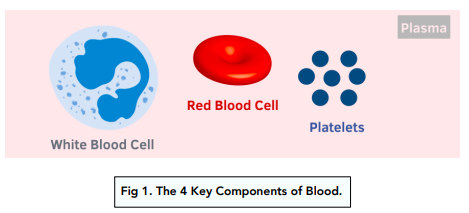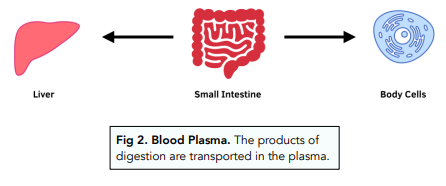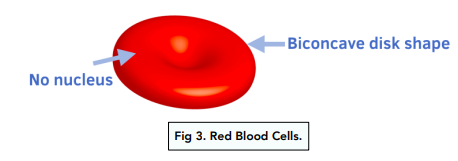Blood and Blood Vessels - Plasma and Red Blood Cells (GCSE Biology)
Blood: Plasma and Red Blood Cells
In this section, we will learn about blood in more detail. Blood has many different components, and each component has a specific job.
Composition of Blood
Blood is made up of four key components:

Plasma
Function
- Plasma is a watery fluid in which holds all the components of blood flow.
- Plasma carries platelets, red and white blood cells, carbon dioxide, digested food including glucose, amino acids and soluble nutrients. It also carries urea, hormones, antibodies, antitoxins, proteins and heat energy.
- Some oxygen is dissolved in plasma, although most oxygen is transported in RBCs (see below).
Structure and Adaptation
- Plasma is clear and watery. This makes it a suitable medium to transport molecules as many of them are soluble in water.
- Different things are transported to different places in plasma. For example, glucose is transported from the small intestine (after digestion) to either the body cells (for respiration) or to the liver (for storage). Hormones are transported from endocrine organs to their target cells.

Red Blood Cells (RBCs)
Function
- RBCs act as carriers of oxygen, transporting oxygen around the body.
- They contain a pigment called haemoglobin, which binds to oxygen, forming oxyhemoglobin. Oxyhaemoglobin remains in this form until it reaches the respiring tissues, where it splits back into oxygen and haemoglobin.

Structure and Adaptation
- RBCs have a biconcave disk shape, which helps to increase their surface area for oxygen exchange. The shape helps RBCs quickly take up and release oxygen when required.
- RBCs also have no nucleus, which means that they have more space to pack in as much haemoglobin as possible so they can carry as much oxygen as possible.

Blood is made up of plasma, red blood cells, white blood cells, and platelets.
Plasma is the yellowish fluid part of the blood that makes up about 55% of its total volume. It contains water, salt, hormones, and waste products.
Red blood cells are the cells that carry oxygen from the lungs to the rest of the body. They are red in color due to the presence of a protein called hemoglobin.
Hemoglobin is a protein in red blood cells that binds to oxygen and helps transport it throughout the body.
Plasma is the fluid part of the blood that contains various substances, while red blood cells are the cells that carry oxygen.
Red blood cells contain hemoglobin, which binds to oxygen in the lungs and transports it to the rest of the body.
Blood vessels are tubes that transport blood throughout the body. There are three main types of blood vessels: arteries, veins, and capillaries. Arteries carry oxygen-rich blood away from the heart, veins carry oxygen-poor blood back to the heart, and capillaries connect arteries and veins and allow for the exchange of oxygen and other substances between the blood and the body’s tissues.
Blood is pumped from the heart through the arteries to the rest of the body, then returns to the heart through the veins. The flow of blood is regulated by the contraction and relaxation of the heart’s muscles and the narrowing and widening of blood vessels.






Still got a question? Leave a comment
Leave a comment